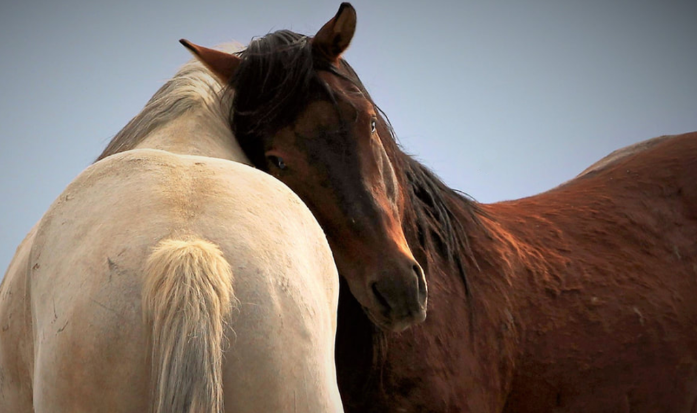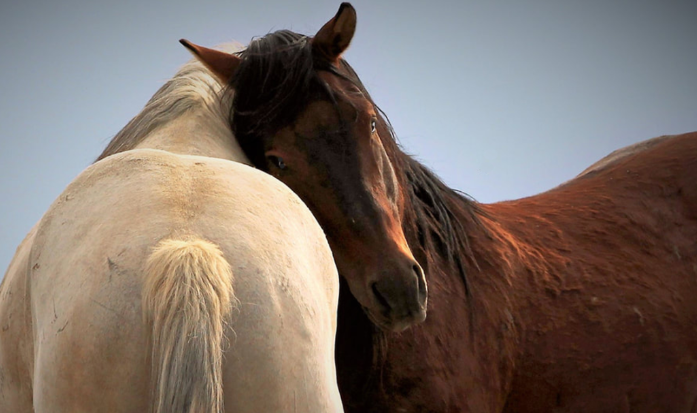Blog
Do Animals Experience Grief When a Human or Animal Companion Dies?


Do Animals Experience Grief When a Human or Animal Companion Dies?
by Jeffrey Richard, Jameson Humane Volunteer
A fundamental principle at the core of Jameson Humane’s mission is that animals are sentient beings who deserve dignity, respect, and empathy equivalent to human beings. But do animals experience a full range of emotions on par with those felt by people? Do they experience sorrow and grief from the loss of an animal’s human and animal companions, pack/herd members and loved ones?
Veterinary literature and anecdotal evidence indicate that animals certainly do mourn the death of human and animal companions and loved ones. In an online publication of Colorado State University’s James L. Voss Veterinary Teaching Hospital, Karissa Bennett writes:
“People with companion animals or service animals will strongly argue that animals express numerous feelings such as fear, anger, shame, excitement, and grief. Historically, wild animals have been known to express grief by letting out a yelp, wandering aimlessly, and eventually reorganizing their pack.
“The human animal bond is a complex social bond which is mutual, affectionate and thrives around a family system. Animals view you as a member of their pack. This bond provides safety and security for the family members and their pets and stabilizes everyone’s wellbeing.
“When a family member, human or animal, is lost, becomes ill, or dies, it affects the whole family. Effectively supporting the grief process in the surviving pack members allows the pack to move forward.
“Animals display grief in a manner similar to humans. Aspects of their personality may change for a period time.”
https://vetmedbiosci.colostate.edu/vth/animal-health/how-animals-grieve
Jameson Humane’s staff members have observed numerous examples of mourning behavior in both companion animals and farmed animals in Jameson’s care. Dawn English is Jameson’s Equine Care Lead. Dawn recalls many times when animals have displayed grief due to the loss of a companion, herd member or other loved one during her 12 years in the field of animal rescue:
“Sadly, I have seen a lot of animals pass and have observed how their herd mates, family and other animals housed near them reacted to the loss. On one occasion, a llama under our care reacted in an unexpectedly mournful way to the passing of a goat in our herd. I came in one morning and our sweet girl had passed away during the night. Our llama housed near the goat sniffed her body, rolled on the ground next to her several times, and lied down next to her for hours until the body was taken away.
“While I was with another rescue organization, I was in charge of caring for a herd of horses and got to know them very well. One pair was so bonded that they groomed each other all the time and even walked in sync. When one of them passed away, we took the other over to say goodbye. At first, he didn’t show much of a reaction but we gave him time alone with his companion while we waited for the truck to pick up the body. After a few minutes, we were quite moved when the survivor groomed the other horse from head to hoof. He then stood in the corner of his paddock, looking away from his friend. He cried out when the truck took his friend away.”
BBC Earth, in its online edition, addressed the question of whether animals (and which animals) experience grief and mourning from the loss of family/herd/pack members in the article entitled “The Truth About Animal Grief.”
“Because mourning is not limited to big-brained cetaceans (whales and dolphins) or primates – scientists have documented some form of ‘death response’ in seals, manatees, dingoes, horses, dogs, housecats, and more. Striking examples include 27 adult giraffes holding a vigil for one dead baby giraffe, elephants from five different families visiting the bones of one of the dead, a group of 15 dolphins slowing their speed to escort a mother dolphin carrying her dead calf, and a strange case of two ducks rescued from a foie gras farm who formed a friendship at their sanctuary home. When one duck died, the other lay with its head on the others neck for hours.
“Though charismatic mammals make headlines, responses to death can also be seen in non-mammals – such as birds, like the foie gras ducks, and wild scrub jays observed in the field.”
The article describes studies which confirmed “grief processing” in a variety of animals. Striking examples were found among primates and bottlenose dolphins who reacted in grief-stricken ways to the loss of infants.
https://www.bbcearth.com/news/the-truth-about-animal-grief
How Can We Help Animals Mourn the Loss of a Loved One?
When we humans learn of a friend or family member who has suffered the loss of a loved one, we help them by providing, for example, emotional support and comfort, ready-to-eat meals, and assistance with arrangements and communications for funeral services and memorials. But when it comes to helping animals go through the grieving process, what can we do?
Dawn English stresses the need to let surviving animals obtain closure by visiting the remains of loved ones:
“It is my firm belief that animals should be allowed to visit the body of a deceased companion or herd/family member and be given a chance to say goodbye. I have seen heartbreaking behavior from animals who were denied the chance to have such closure. One example occurred when two bonded, inseparable horses were rescued from a fire. One of the horses grew ill and had to be rushed to U.C. Davis but never returned. The surviving horse would get worked up every time a trailer came on the property, running alongside of it and calling out.
“Even after a long separation between a deceased animal and a survivor, it is beneficial to try to allow the survivor to see the body of the deceased in order to gain some sense of closure. On one occasion, a gelding and a mare who were in neighboring stalls developed a connection. But they were separated when the rescue moved to a new location. At least a year later, the mare had to be euthanized. We brought the gelding over to the mare’s stall to see her, thinking that it might provide some closure to him. It was clear that he remembered her. He sniffed every inch of her body and groomed her face.”
Jaime Vega, Jameson’s Companion Animal Manager, echoes the need to give surviving animals the closure that comes from visiting the remains of a deceased companion or loved one:
“With an animal in a herd passing, it is very beneficial for the survivors, especially those who were bonded with the deceased, to see the body and to be able to see that they are not coming back. This gives those animals some closure by knowing what’s going on. The same thing holds true with the passing of an animal’s human guardian. As the fabled Hachiko tale in Japan shows, dogs are very loyal and loving companions. We don’t have any way to communicate directly with animals that their human companions aren’t coming back when they pass away. As a result, unless they are given the chance to see a loved one’s remains, the surviving animals may spend the rest of their lives longing and yearning for their person or animal companion to come through the door. From an animal’s perspective, knowing that their guardian has passed and is no longer with them is still equally as heartbreaking, although it provides some comfort and closure in knowing and the possibility of the animal living a fulfilling life long after their guardian has passed.”
The importance of closure, and the instinctual need of surviving herd/pack/family members to visit and pay respects to the remains of decedents were demonstrated in a recent documentary produced by National Geographic entitled “Secrets of the Elephants.” In the first episode of Season 1, the film focuses on elephants of the African Savanna and the closeness of the families comprising the herd. One elder statesman of the herd, Tolstoy, was a “super-tusker” (one with gigantic tusks nearly dragging the ground), who was revered by the herd, especially by other bulls. Upon his death, many elephants came from miles away in the Savanna and, one by one during the night, paid respects to Tolstoy by gently touching his body with their trunks. The narrator observes:
“There is a ritual to their grief. Their actions speak to the depths of their bonds, bonds that endure beyond death.”
https://www.nationalgeographic.com/tv/shows/secrets-of-the-elephants
In addition to letting a surviving pet or other animal view a deceased companion’s body, what else can we do to ease the survivor’s grief and facilitate recovery? The Colorado State University article cited above provides useful insight and recommends the following steps:
- “If the eating habits change in the surviving animals . . . leave the deceased pet’s beds, water, and food bowls around for a few days after the death.”
- “Most animals sleep in pairs; if this routine is changed, they may sleep in different areas and become restless where they once slept peacefully. Things you can do to support the change in sleeping habits is to make time for more exercise, walk, hike, and play more often. When there is an opportunity to go for a drive, be spontaneous. Creating new memories will help heal the grief and allow the pack to naturally reorganize.”
- “Engage the surviving animals in activity. This may be a time of introducing a new leadership. Be sure to use positive reinforcements and gentleness to encourage these changing roles. Keep a regular schedule to best support the grief of the animals that express anxiety.”
- “Spend extra time together; sometimes allowing our pets to take care of us is just what they need as well. They will get through their grief in their own time in their own unique way.”
- “Comforting grief in pets is similar to comforting grief in humans. Various expressions of grief will fluctuate from day to day, and sometimes hour by hour. Remember, grief is not black or white. Grief can be gray. The important thing is to be patient with your animal and understand that although grief can feel like a roller coaster ride in the beginning, eventually the ride will smooth out.”
https://vetmedbiosci.colostate.edu/vth/animal-health/how-animals-grieve
Jameson Humane Can Help
If you have questions or are encountering a situation where your animal companions or herd members are suffering from the loss of a loved one or companion in ways that the suggestions above do not seem to be easing, please contact Jameson Humane by reaching out to our Founder, Monica Stevens, at 707-815-8153 or Monica@JamesonHumane.org.
Next month, we will address the related topic of how our society views the sorrow and deep feeling of loss that we humans suffer when we lose an animal, and the resources available to help you go through your own grieving process.
